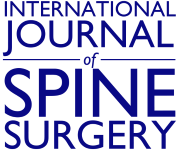Abstract
Background Emerging data have highlighted the significance of planning and aligning total and segmental lumbar lordosis with pelvic morphology when performing short-segment fusion with the goal of reducing the risk of adjacent segment disease while also decreasing spine-related disability. This study evaluates the impact of personalized interbody implants in restoring pelvic incidence–lumbar lordosis (PI−LL) mismatch compared with a similar study using stock interbody implants.
Methods This multicenter retrospective analysis assessed radiographic pre- and postoperative spinopelvic alignment (PI−LL) in patients who underwent 1- or 2-level lumbar fusions with personalized interbody implants for degenerative (nondeformity) indications. The aim was to assess the incidence of malalignment (PI−LL ≥ 10°) both before and after fusion surgery and to determine the rate of alignment preservation and/or correction in this population.
Results There were 135 patients included in this study. Of 83 patients who were aligned preoperatively, alignment was preserved in 76 (91.6%) and worsened in 7 (8.4%). Among the 52 preoperatively malaligned patients, alignment was restored in 23 (44.2%), and 29 (55.8%) were not fully corrected. Among patients who were preoperatively aligned, there was no statistically significant difference in either the “preserved” or “worsened” groups between stock devices and personalized interbody devices. In contrast, among patients who were preoperatively malaligned, there was a statistically significant increase in the “restored” group (P = 0.046) and a statistically significant decrease in the “worsened” groups in patients with personalized interbodies compared with historical stock device data (P < 0.05).
Conclusions Compared with a historical cohort with stock implants, personalized interbody implants in short-segment fusions have shown a statistically significant improvement in restoring patients to normative PI−LL. Using 3-dimensional preoperative planning combined with personalized implants provides an important tool for planning and achieving improvement in spinopelvic parameters.
Level of Evidence 3.
Footnotes
Funding This work was supported by funding from Carlsmed.
Declaration of Conflicting Interests Jahangir Asghar discloses that he is a clinical research investigator and receives consulting fees from Carlsmed. Ashvin I. Patel discloses that he receives consulting fees from Carlsmed. Joseph A. Osorio discloses that he is a clinical research investigator and receives consulting fees from Carlsmed. Justin S. Smith discloses that he is a shareholder and receives consulting fees from Carlsmed. John Small discloses that he is a clinical research investigator for Carlsmed. Jeffrey P. Mullin discloses that he is a clinical research investigator and receives consulting fees from Carlsmed. Atman Desai discloses that he receives consulting fees from Carlsmed. Michele Temple-Wong discloses that she is an employee of Carlsmed. Rodrigo J. Nicolau discloses that he is an employee of Carlsmed.
Disclosures In addition to the relationships described in Declaration of Conflicting Interests, Atman Desai reports consulting fees from Stryker. Jeffrey Mullin reports consulting fees from Medtronic, Globus, and SI Bone, and serves on the CNS and AANS/CNS Joint Spine Section Executive Committee. Joseph Osorio reports grants/contracts from Medtronic; royalties/licenses from Alphatec; consulting fees from Alphatec, Medtronic, and DePuy. John Small reports royalties/licenses from Astura Spine. Justin Smith reports grants/contracts from SeaSpine/Orthofix, NREF, AOSpine, and DePuy Synthes/ISSGF; royalties/licenses from Highridge and Globus/NuVasive; consulting fees from Highridge, SeaSpine/Orthofix, Medtronic, Cerapedics, and Globus/NuVasive; support for attending meetings from AOSpine; serving on the SRS Board of Directors and ISSGF Executive Committee; and stock/stock options from Alphatec and Globus/NuVasive.
IRB Approval This study utilized secondary research consisting of deidentified data for which consent is not required and was therefore exempt from institutional review board review under 45 CFR §46.104 (d)(4)(ii). No direct patient involvement occurred.
- This manuscript is generously published free of charge by ISASS, the International Society for the Advancement of Spine Surgery. Copyright © 2024 ISASS. To see more or order reprints or permissions, see http://ijssurgery.com.






